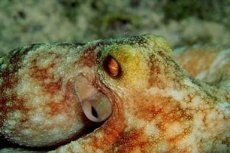 There are about 200 known species of octopus. They range
in size from a few inches to (12 ft). The common octopus is found in all
oceans and grows to 90 cm (3 ft) in length. Around New Zealand they mostly
live in shallow coastal waters, inside dens or small caves on the ocean bottom.
They live alone and some will even block the entrance to the den with rocks
to keep intruders out!
There are about 200 known species of octopus. They range
in size from a few inches to (12 ft). The common octopus is found in all
oceans and grows to 90 cm (3 ft) in length. Around New Zealand they mostly
live in shallow coastal waters, inside dens or small caves on the ocean bottom.
They live alone and some will even block the entrance to the den with rocks
to keep intruders out!
The mantle of the octopus looks like a wrinkled leather sack. In front of the eyes are eight arms. The arms may have as many as 240 suction cups on the underside, in two rows. If a predator bites off an arm, it will grow back over time.
In the centre of the arms is the mouth and beak. The beak, which is used for feeding, looks very much like a parrot's beak. It is used to crush t he shells of crabs and lobsters, which are the octopus' favourite food. Once the beak has pierced the prey, a poison glad will inject a nasty substance into its body. The poison paralyses the prey and softens the meat so that the octopus can suck all of the flesh into its small mouth. In this way, it devours everything but the shell.
Often, a diver can locate an octopus den by looking for a pile of empty shells that have been tossed out after feeding.
Because the octopus does not have a shell, it can squeeze into and out of very small openings.
If attacked, the first thing that an octopus can do is change colours. It can make the colour of its body match the surroundings. It has special colour cells all over its body that expands and contracts to control the pigments inside. Its mantle may appear red-brown, yellow-orange, blue-green, or even white. The texture of the mantle can be changed as well. It can be camouflaged to look like rock, coral or seaweed.
If these tactics do not work, and there is no shelter available, the octopus can release a cloud of black ink. The ink does two things that will help it to escape. First, it hides the animal. The second thing that the ink does is to temporarily destroy a predator's sense of smell.
The octopus usually remains inside of its lair unless it is searching for food. Yet there is one time in its short life when it does not look for food at all. In the common octopus, the female is so devoted to the care of her eggs that she does not eat at all after they have been shed. After mating, a female may lay as many as 45,000 eggs, which she attaches to the roof of her den. She will take care of the eggs during the development period, this can last up to 1-2 months. She never leaves the eggs, not even to look for food. Unfortunately, soon after the eggs hatch and release hundreds of tiny octopuses, the mother will die.